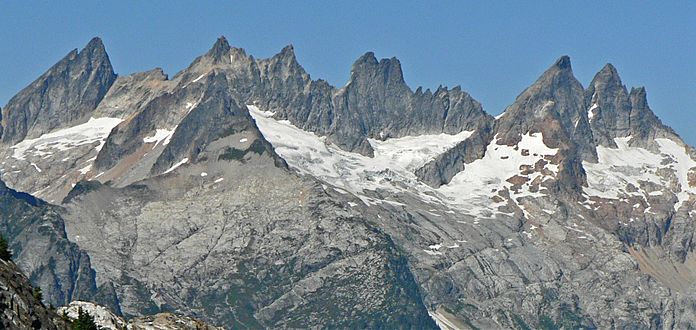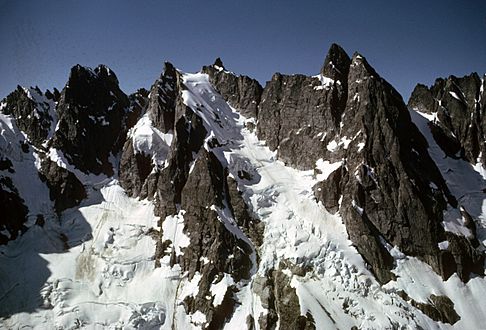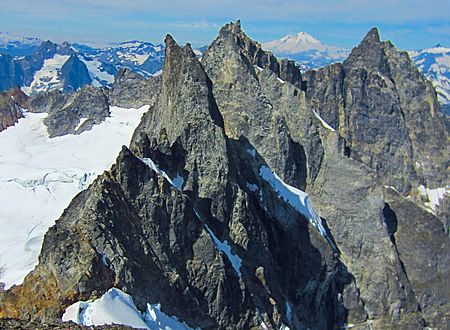Inspiration Peak (Washington) facts for kids
Quick facts for kids Inspiration Peak |
|
|---|---|

Inspiration Peak above part of Terror Glacier
|
|
| Highest point | |
| Elevation | 7,880 ft (2,400 m) |
| Prominence | 240 ft (73 m) |
| Geography | |
| Location | North Cascades National Park Whatcom County, Washington |
| Parent range | Picket Range Cascade Range |
| Topo map | USGS Mount Challenger |
| Type of rock | Skagit Gneiss |
| Climbing | |
| First ascent | 1940 by brothers Helmy and Fred Beckey |
| Easiest route | Climbing YDS 5.6 via West Ridge |
Inspiration Peak is a tall mountain in Washington. It stands about 7,880 feet (2,402 meters) high. You can find it in the Picket Range, which is part of the North Cascades National Park.
This peak is located close to other mountains. It's just a short distance east of Mount Degenhardt. It's also west of McMillan Spires. You can see parts of Terror Glacier to the south of the peak. Other glaciers, called McMillan Cirque glaciers, are on the north side.
The very first time someone climbed Inspiration Peak was in 1940. It was climbed by two brothers, Fred Beckey and Helmy Beckey. They used a path called the West Ridge. If the weather is clear, you might even spot Inspiration Peak from the visitor center at North Cascades National Park in Newhalem.
Mountain Weather and Climate
Inspiration Peak is in a place with a "marine west coast" climate. This means it gets a lot of weather from the Pacific Ocean. Most storms start over the ocean and move towards the Cascade Mountains.
When these storms reach the mountains, the air is forced to rise. This makes the air cool down and drop its moisture. So, the west side of the North Cascades gets a lot of rain or snowfall. This happens especially during the winter months.
In winter, it's often cloudy. But in summer, high-pressure systems over the Pacific Ocean bring clear skies. Because the ocean affects the weather, the snow here is often wet and heavy. This can lead to a high risk of avalanches.
How the Mountains Were Formed
The North Cascades area has very rugged land. You can see sharp peaks, tall spires, long ridges, and deep glacial valleys. All these different shapes were created by geological events that happened millions of years ago. These events also caused big changes in how high the land is, which affects the climate.
The Cascade Mountains started forming millions of years ago. This was during a time called the late Eocene Epoch. The North American Plate was slowly moving over the Pacific Plate. This movement caused many volcanic eruptions.
Also, small pieces of the Earth's crust, called terranes, joined together. These pieces of both oceanic and continental land helped create the North Cascades about 50 million years ago.
Later, during the Pleistocene period (which started over two million years ago), glaciers played a big role. These huge ice sheets moved forward and backward many times. As they moved, they scraped away the land, leaving behind rock debris. The river valleys in the area now have a "U" shape. This shape is a result of these recent glaciers.
The tall peaks and deep valleys of the North Cascades were mostly formed by two main things. One is the land being pushed up (called uplift). The other is faulting, where cracks in the Earth's crust cause sections to move. These, along with glaciation, shaped the landscape we see today.
Gallery
-
Terror, Degenhardt, Inspiration, McMillan Spires seen from the south
- Weather forecast: Inspiration Peak






